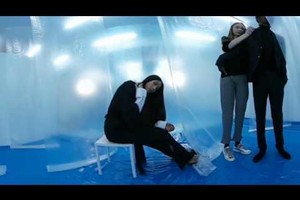An Artist's Statement
Written by Pat Perry by Michaela WidergrenThe aim of my artwork has always felt more to me like the aim of a writer. Making artwork has always been a push to make sense of this whole thing and to share a conversation with others about the short time I’ve been alive, through imagery. Each piece plays a role as a particular slice of a larger story, and is made in an effort to share the beauties and tragedies that everyday life brings. The past is how we put the present into context, especially with our own personal memories, and I’ve found this motif useful in my pictures. Even memories fail us over time though, and we can only hope to use them to stitch sense together in the realm of our tiny blip on a timeline: a timeline that stretches in both directions indefinitely.
The things that seem important right now, for reasons of survival, or for pleasure, are absurd to put an imbalanced focus on, and imply that these things are important indefinitely. To focus on endeavors with short-term rewards, would be shortsighted. Thus, the ephemeral ideal places all things on an equal plane. Each person must struggle to categorize and organize these things into something that informs the way they’d like to look at, and carry out living the rest of their life. My artwork works as a survey. It acts as a book of short stories. It acts as a list. I am collecting the end product of the rigorous filtration process that this awareness of impermanence has informed and created.
Through making art, I aim to pull an audience the same way I strive to pull myself. Pull them out of normality and transport them to an unfamiliar place in which they can experience wonder on a small scale. A place where memories can be an activator. I record and survey my perceptions through many different places and situations. More than any specific line-work or paint application, my artwork is defined by the lengths I’ve gone to constantly keep myself uncomfortable; to exist in unordinary situations so that I can come at this from the side, and gather a strong set of primary and diverse situations that teach me where to place value and how to be empathetic with others. I then share these recordings with others in hopes that they find these recordings eye opening and will be encouraged to revisit their own assumptions pertaining to how they measure importance. The work depicts people, places, and subjects that have texture and retain their character despite our divulging decent into a clean, safe, blank, globalized social order.
Words escape us during the very moments we feel most alive, the moments that remind us of our humanity. This is not to say that these moments are incommunicable. They come at different times for everyone. We have to listen and be ready for them. As a person, I meticulously strive to increase my emotional capacity and stay ready. As an artist, I’m scratching and scrambling for anyway to communicate it, and to open a line for correspondence. Artwork is just a vehicle; one that I am constantly trying to rebuild and improve so that it safely transports as much core content as possible, without letting too much fly out of the back of the pickup truck on the way home.
It is important that we acknowledge the futility of hoping to totally recreate the moments themselves. The real beauty is in the experience, but artwork can acknowledge that idea, fortify that idea, and celebrate that experience. Wherever the particular place may be, and whatever the survey is focused on with each new body of work, the search goes on. My process starts out with lots of sketching, writing and photographing. These three activities are the main ways I can collect data during times that would be inconvenient to create a full, completed artwork. I can then work from that data to combine these fragments of place or object with an allegorical vocabulary and patterns from my imagination. Whether using paint, graphite, film, or ink as a medium, I combine imaginative subject matter and patterns with scenes and objects from everyday life to instill a balance of familiarity without the fallacy of assumption.
Ordinary or extraordinary, insignificant or significant, these decisions are for each of us to make on our own. Too long we have apathetically let societal foundations overbearingly decide these for us. In deciding for myself and making it apparent in my artwork, I am promoting to restart the conversation. All is on an equal, inescapable path to completion, and we are all just ants, alive for a day. We don’t need this to be a dreadful notion; it’s a liberating notion. People can and must interpret and decide individually, for themselves. With that being said, it’s irrelevant what one might take out of one specific piece or image I’ve created. What is relevant and most important is that a viewer looks at it and sees the beauty in a decent, critical, ethical, and honest look at what it means to be here; what it means to be here.


























